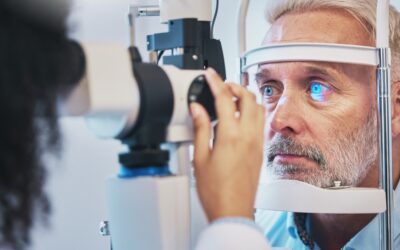Table of Contents
Genetic ophthalmology (GO) is an emerging field that could provide more effective treatment for genetic eye diseases such as glaucoma. However, GO also raises some serious concerns that should be addressed as this technology progresses.
What is Genetic Ophthalmology?
A mixture of genetic and environmental factors determines eye health. Overall, no one is sure whether environmental or genetic factors are more important. However, some recent research suggests that while healthy eyes may not always be genetic, environmental factors aren’t as significant.
That’s not to say environmental factors don’t matter. Smoking and excessive sunlight may be the two biggest such factors that determine eye health.
Beginning in the late 1990s, researchers focused on adeno-associated viruses (AAVs) and their impact on eye health. Some researchers believe AAVs could unlock advanced genetic engineering features. In particular, as far as the eyes are concerned, researchers have linked AAVs with genetic eye diseases like:
-
AMD (Age-related Macular Degeneration): As we age, small fat deposits accumulate in and around the eyes and obscure vision. Symptoms include overall blurry vision or a blurry vision spot. In clinical trials, AAV tinkering has prevented AMD, even among people with serious risk factors.
-
LCA (Leber’s Congenital Amaurosis): This rare eye disease is also age-related, but it’s usually a birth defect. AAV research in the early 2000s led to FDA approval of Luxterna (voretigene neparvovec), a drug that halts genetic mutations which cause retinal dystrophy.
-
Choroideremia: This eye condition, which is also a birth defect, causes males to go blind gradually over many years. In a 2014 clinical trial, vision improved for six of six patients who received subretinal AAV injections.
Scientists are also hopeful that AAV manipulation might improve or cure color blindness, but this research is in the very early stages.
How Does GO Work?
Glasses and contacts are non-invasive vision correction devices. Laser surgery is a minimally invasive procedure. GO is usually the next step up. These interventions typically don’t require extended hospital stays but aren’t minimally invasive either.
Retinal gene therapy might be the most effective approach. A doctor inserts AAV into retinal cells. This procedure is effective for people with AMD, glaucoma, and other retinal diseases. Retinal cells don’t divide, so a single treatment lasts several years.
AAV tropism (rotating a cell to stimulate certain areas) is a close second. A doctor injects AAV under the retina into the tiny space between the RPE layer and the photoreceptors. That’s a very delicate and risky procedure. However, if done correctly, the RPE absorbs the fluid and, usually within about 14 hours, the retina flattens out.
Keep in mind that GO is still in very early developmental stages. As research continues, scientists will probably refine the tactics, making them more available to everyday people.
However, no advances change the fact that GO is invasive and risky. Patients must simply choose between an invasive procedure that could potentially correct the worst vision problems or eyeglasses and contacts that manage the symptoms of these diseases but that don’t alter the possibility of progression.
Genetic eye disease research also involves some potential risks. If people know about genetic vision health risks, employers and providers can also find out about them. They could use this information to make decisions such as ending employment or raising insurance premiums.
The 2008 Genetic Information Nondiscrimination Act addresses these issues. Title I applies to genetic employment discrimination. Title II prohibits genetic discrimination in healthcare plans.
Can Genetic Tests Help Us Avoid Eye Problems?
If research continues progressing, then the answer to this question is definitely “yes.” Genetic testing could be useful for treatments, as outlined above, as well as the prevention and early detection of serious eye problems. Additionally, genetic research could help non-invasive corrective measures work better.
AMD is an excellent example of prevention and early detection. This progressive disease almost always affects people over age 65. If an optometrist ran a genetic eye test on a much younger person, and if that test revealed an AMD predisposition, optometrists could begin AMD treatments immediately and potentially prevent this disease altogether.
Our genes also determine how we respond to corrective lenses and other such measures. This genetic information, especially when combined with emerging smart eyeglasses technology, could be a game-changer for those who prefer non-invasive procedures.
Nothing can alter genetics, but regular eye checkups allow optometrists to detect problems early and get ahead of them. Therefore, routine exams might be the most essential part of a good prepaid vision care plan. If the plan only covers corrective work, like glasses and contacts, people only see optometrists as needed. Therefore, serious genetic-related problems could grow undetected for years.
With the potential of GO and the power of preventive eye care, it’s easy to see why investing in a pre-paid vision plan is so important.





















































